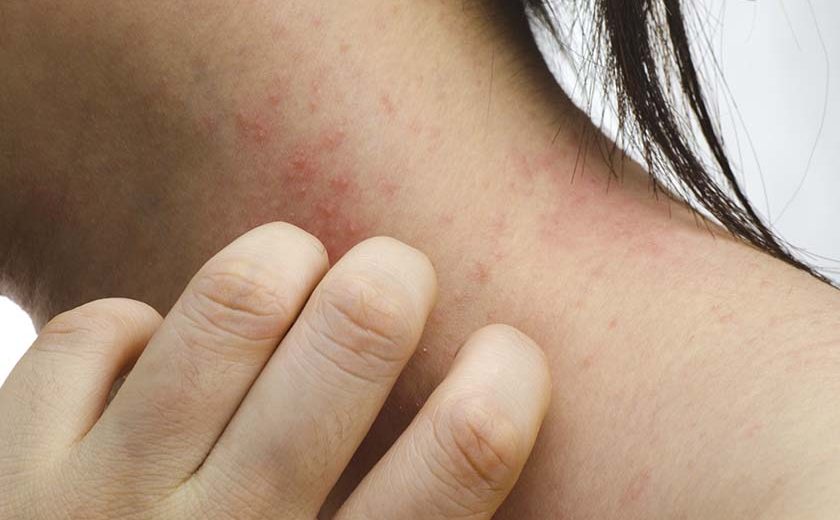Eczema is a term for a group of medical conditions that cause the skin to become inflamed or irritated.
The word eczema originated from the Greek words “ek” which means out and “zein” which means boil, put together “ekzein or ekzema” that means boil-out or boil-over; referring to the inflamed bubbles or blisters that appear on the skin. It is a highly individual condition which varies from person to person and comes in many different forms. It is not contagious. In mild cases of eczema, the skin is dry, scaly, red and itchy. In more severe cases there may be weeping, crusting and bleeding. Constant scratching causes the skin to split and bleed and also leaves it open to infection. Eczema affects people of all ages but is primarily seen in children.
The Human Skin
In order to get a better understanding of Eczema, it is important to gain an insight into the skin and its role. The skin provides a strong, effective barrier that protects the body from infection or irritation. Skin is made up of a thin outer layer, a fairly elastic one in the middle, and a fatty layer at the deepest level. Each layer contains skin cells, water and fats, all of which help maintain and protect the condition of the skin.
Healthy skin cells are plumped up with water, forming a protective barrier against damage and infection. Fats and oils in the skin help retain moisture, maintain body temperature and also prevent harmful substances or bacteria from entering the body.
The eczematous skin may not produce as much fats and oils, and will be less able to retain water. The protective barrier is therefore not as good as it should be. Gaps open up between the skin cells because they are not sufficiently plumped up with water. Because it is prone to drying out and is easily damaged, the eczematous skin is more liable to become inflamed and sensitized.
Causes of Eczema
The specific cause of eczema remains unknown, but it is believed to develop due to a combination of hereditary (genetic) and environmental factors. Children are more likely to develop eczema if a parent has had it or another atopic disease. If both parents have an atopic disease, the chances increase further. Environmental factors are also known to bring out the symptoms of eczema; these include irritants (soaps, detergents, shampoos, disinfectants), allergens (dust mites, pets, pollens, mold, dandruff),microbes (bacteria, viruses, and certain fungi),weather conditions(very hot or cold weather, high and low humidity), food (dairy products, eggs, nuts and seeds, soy products, wheat), stress (it is not a cause of eczema but can make symptoms worse), hormones (women can experience worsening of eczema symptoms at times when their hormone levels are changing, for example during pregnancy and at certain points in their menstrual cycle).
Prevalence and Statistics
Eczema was earlier thought to be a common inflammatory skin disease that affects 4% to 7% of adults, and 15% to 25% of children worldwide and as per the statistics the highest numbers of eczema patients belong to the Asia.
Atopic eczema is the most common type of eczema. Research shows that atopic eczema can affect two in every 10 people in Malaysia and about 10%-14% of children below the age of 14. This is especially true among urbanized communities.
Types of Eczema
There are many variants or types of eczema diagnosed and recorded, but the most common 8 eczematous conditions are:
1. Atopic Dermatitis
Atopic Dermatitis (AD) is the most common type of eczema that is chronic and inflammatory. It happens when the immune system goes into overdrive. AD usually begins in childhood, often in the first six monthsof the life. It is part of what’s called the atopic triad, which includes two other allergic conditions, namely asthma and hay fever, which is also known as allergic rhinitis. Researchers believe that people who come from families with a history of AD, asthma and/or hay fever are more likely to develop AD themselves. Some common symptoms of AD are dry, scaly skin, redness (erythema), itching, cracks behind the ears, rashes on the cheeks, arms and legs, open, crusted or “weepy” sores (usually during flare-ups)
2. Contact Dermatitis
Contact Dermatitis (CD) happens when the skin touches irritating substances or allergens. These make the skin inflamed, causing it to burn, itch and become red. There are two kinds of CD,namely irritant and allergic. CD usually appears on the hands, orparts of the body that touched the irritant/allergen. The most common irritants include solvents, industrial chemicals, detergents, fumes, tobacco smoke, paints, bleach, wool, acidic food, astringents, some soaps and fragrances, allergens (usually animal dander or pollens). Symptoms of contact dermatitis are redness and rashes, burning or swelling, blisters that may weep or crust over.
3. Neurodermatitis
Neurodermatitis also known as Lichen Simplex Chronicus is an itchy skin disease that is similar to AD. People with neurodermatitis tend to get thick, scaly patches on their skin as a result of too much rubbing and scratching of the area. Women are more commonly affected by neurodermatitis than men, and the condition is most frequent in people aged between 20 and 50. Some symptoms of neurodermatitis are thick, scaly patches on the nape of the neck, scalp, shoulders, on the bottoms of feet, on ankles, wrists and the backs of the hands, itching, discolored skin.
4. Dyshidrotic Eczema
Dyshidrotic eczema is a condition that produces small, itchy blisters on the edges of the fingers, toes, palms, and soles of the feet. Stress, allergies (such as hay fever), moist hands and feet, orexposure to nickel (in metal-plated jewelry), cobalt (found in metal-plated objects, and in pigments used in paints and enamels), or chromium salts (used in the manufacturing of cement, mortar, leather, paints, and anticorrosives) may be “triggers” of dyshidrotic eczema. This type of eczema is twice as common in women as it is in men. Symptoms of dyshidrotic eczema include small fluid-filled blisters (vesicles) on the fingers, hands, and feet, itching, redness, flaking, scaly, cracked skin.
5. Seborrhoeic Dermatitis
Considered a chronic form of eczema, seborrheic dermatitis appears on the body where there are a lot of oil-sebaceous glands likethe upper back, nose and scalp. Genetics and hormonal levels play a major role in its development. Microorganisms such as yeast that live on the skin naturally can also contribute to seborrheic dermatitis. Unlike many other forms of eczema, seborrheic dermatitis is not the result of an allergy. People of any age can develop seborrheic dermatitis including infants (known as “cradlecap”). It is slightly more common in men than women.Seborrheicdermatitis often appears on the scalp, where symptoms may range from dry flakes (dandruff) to yellow, greasy scales with reddened skin. Patients can also develop seborrheic dermatitis on other oily areas of their body, such as the face, upper chest and back. Common symptoms of seborrheic dermatitis include redness, greasy, swollen skin, white or yellowish crusty flakes.
6. Nummular or Discoid Dermatitis
Nummular or discoid eczema is a type of eczema that looks very different than the usual eczema and can be much more difficult to treat. People with nummular eczema develop coin-shaped spots on their skin, which may be very itchy. It is thought to be “triggered” by insect bites, reactions to skin inflammation, or dry skin in the winter. This form of eczema is relatively uncommon and occurs most frequently in elderly men. Some symptoms of nummular eczema include: round, coin-shaped spots, itching, dry, scaly skin, wet, open sores.
7. Statis Dermatitis
Stasis dermatitis also called as varicose eczema or venousstasis dermatitis because it usually happens when there is a problem with blood flow inthe veins and pressure develops (usually in the lower legs). This pressure can cause fluid toleak out of the veins and into the skin, resulting in stasis dermatitis. Symptoms of stasis dermatitis include swelling around the ankles, redness, scaling, itching, pain; and in more severe cases oozing, open areas (cracking or larger ulcers) and infection.
8. Eczema Herpeticum
Eczema herpeticum is a serious skin infection caused by the herpes simplex virus that can affect people with atopic eczema. The condition can affect any part of the body, but is most common on the face. Symptoms of eczema herpeticum are high temperature, shivering, swollen lymph glands and clusters of itchy blisters or punched-out erosions.
Management of Eczema
There is no fixed treatment schedule or prescription dose for eczema. Treatment for the condition aims to heal the affected skin and prevent flaring of the symptoms. Management of the condition will revolve around age, symptoms and other underlying conditions. For some people, eczema goes away over time, and for others, it remains a lifelong condition.
Some of the following self-management techniques can help improve eczematous conditions:
- Taking lukewarm baths.
- Applying moisturizer within 3 minutes of bathing to “lock in” moisture.
- Moisturizing regularly.
- Wearing cotton and soft fabrics, avoiding rough, scratchy fibers, and tight-fitting clothing.
- Using mild soap or a non-soap cleanser when washing.
- Air drying or gently patting skin dry with a towel, rather than rubbing skin dry after bathing.
- Avoiding rapid changes of temperature.
- Learning individual eczema triggers and avoiding them.
- Using a humidifier in dry or cold weather.
- Keeping fingernails short to prevent scratching from breaking skin.
The healthcare practitioner may prescribe medications depending on the condition ranging from antiinfectives, antihistamines, antiinflammatory, immunomodulators, probiotics or corticosteroids either to be applied on the skin or to be consumed orally. Even after the eczematous condition has healed or improved, it is important to keep looking after it and avoiding the trigger factors, as it can easily resurface.
References:
1) Types of Eczema; National Eczema Society, London; http://www.eczema.org/varicose; accessed
September 2017.
2) Statistics of Eczema in Malaysia; Bookrev; March 6, 2016; http://www.paccga.net/eczema-medication/statistics-of-eczema-in-malaysia; accessed September 2017.
3) 8 types of Eczema; Eczema Health Centre; WebMD; http://www.webmd.boots.com/skin-problems-and-treatments/eczema/eczema-types; accessed September 2017.
4) Dr. Chin-Yun Lin; 2010; Eczema herpeticum; DermNet New Zealand; https://www.dermnetnz.org/topics/eczema-herpeticum; accessed September 2017.
 Abraham Mathew Saji is a pharmacist by qualification, engaged in research and development of medicines and their implications on the human body. He is an avid reader in pursuit of knowledge and understanding of technological advancements in the medical and pharmaceutical world. He is even more passionate about sharing his acquired knowledge, which he does by speaking at conferences, lectures and writing. He can be contacted at maz31abr@gmail.com for any clarification.
Abraham Mathew Saji is a pharmacist by qualification, engaged in research and development of medicines and their implications on the human body. He is an avid reader in pursuit of knowledge and understanding of technological advancements in the medical and pharmaceutical world. He is even more passionate about sharing his acquired knowledge, which he does by speaking at conferences, lectures and writing. He can be contacted at maz31abr@gmail.com for any clarification.


